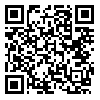Sat, Apr 27, 2024
Volume 33, Issue 1 (1-2023)
JHNM 2023, 33(1): 43-51 |
Back to browse issues page
Download citation:
BibTeX | RIS | EndNote | Medlars | ProCite | Reference Manager | RefWorks
Send citation to:



BibTeX | RIS | EndNote | Medlars | ProCite | Reference Manager | RefWorks
Send citation to:
Mohamed Abobaker R, Sulaiman Alamri M, Alshaery B, M. Hamdan-Mansour A. Impact of Jigsaw Cooperative Learning Strategy on academic achievement and opinion among Nursing Students. JHNM 2023; 33 (1) :43-51
URL: http://hnmj.gums.ac.ir/article-1-1987-en.html
URL: http://hnmj.gums.ac.ir/article-1-1987-en.html
Randa Mohamed Abobaker1 

 , Majed Sulaiman Alamri2
, Majed Sulaiman Alamri2 

 , BaderJamaan Alshaery3
, BaderJamaan Alshaery3 

 , Ayman M. Hamdan-Mansour *
, Ayman M. Hamdan-Mansour * 

 4
4


 , Majed Sulaiman Alamri2
, Majed Sulaiman Alamri2 

 , BaderJamaan Alshaery3
, BaderJamaan Alshaery3 

 , Ayman M. Hamdan-Mansour *
, Ayman M. Hamdan-Mansour * 

 4
4
1- Assistant Professor,Nursing Department, Gulf Colleges, Hospitals and Health Services Administration Department, Hafr El Batin Governorate, Hafr Al Batin, Saudi Arabia
2- Assistant Professor, Nursing Department, College of Applied Medical Science, University of Hafr El Batin, Hafr AlBatin, Saudi Arabia
3- Assistant Professor, Education and Psychology Department, College of Education, Hafr El Batin University, Saudi Arabia;
4- Professor, Department of Community Health Nursing, School of Nursing-The University of Jordan, Amman -11942- Jordan , a.mansour@ju.edu.jo
2- Assistant Professor, Nursing Department, College of Applied Medical Science, University of Hafr El Batin, Hafr AlBatin, Saudi Arabia
3- Assistant Professor, Education and Psychology Department, College of Education, Hafr El Batin University, Saudi Arabia;
4- Professor, Department of Community Health Nursing, School of Nursing-The University of Jordan, Amman -11942- Jordan , a.mansour@ju.edu.jo
Abstract: (876 Views)
Introduction: Employing innovative teaching strategies is urgently needed for nursing education systems.
Objective: This study aimed to determine the effectiveness of the jigsaw cooperative learning strategy on nursing students’ academic achievement and opinions.
Materials and Methods: This research is a randomized controlled trial. The study sample consisted of 160 nursing students randomly selected and assigned to the intervention (80 students in 8 groups of 10 students each) and the control group (80 students in another 8 groups of 10 students each). The study data were collected at two time points after the intervention. A self-administered questionnaire was used to collect data about students’ academic achievement and opinions regarding the jigsaw cooperative learning strategy (only for the intervention group). The Chi-squared test and repeated measure analysis of variance (ANOVA) were used for data analysis.
Results: The mean age of the experimental group was 20.8±0.74 years, while that of the control groups was 20.7±0.81 years. There is a significant difference in mean scores of academic achievements between the control and intervention groups (P=0.001) over time based on repeated measure ANOVA, and a significant difference between the two groups over time group effect by using repeated measure ANOVA (P=0.001). The paired t-test showed a significant difference between students’ academic performance in time I and time II (P<0.05). In the control group, the descriptive statistics show that students’ academic achievement (time I) was slightly higher in the posttest (time I) and dropped slightly in time II. The paired t-test showed a nonsignificant difference between students’ academic performance in time II and time I.
Conclusion: The results indicated the substantial need for using novel nursing education models in nursing education to enhance learning outcomes in training settings.
Objective: This study aimed to determine the effectiveness of the jigsaw cooperative learning strategy on nursing students’ academic achievement and opinions.
Materials and Methods: This research is a randomized controlled trial. The study sample consisted of 160 nursing students randomly selected and assigned to the intervention (80 students in 8 groups of 10 students each) and the control group (80 students in another 8 groups of 10 students each). The study data were collected at two time points after the intervention. A self-administered questionnaire was used to collect data about students’ academic achievement and opinions regarding the jigsaw cooperative learning strategy (only for the intervention group). The Chi-squared test and repeated measure analysis of variance (ANOVA) were used for data analysis.
Results: The mean age of the experimental group was 20.8±0.74 years, while that of the control groups was 20.7±0.81 years. There is a significant difference in mean scores of academic achievements between the control and intervention groups (P=0.001) over time based on repeated measure ANOVA, and a significant difference between the two groups over time group effect by using repeated measure ANOVA (P=0.001). The paired t-test showed a significant difference between students’ academic performance in time I and time II (P<0.05). In the control group, the descriptive statistics show that students’ academic achievement (time I) was slightly higher in the posttest (time I) and dropped slightly in time II. The paired t-test showed a nonsignificant difference between students’ academic performance in time II and time I.
Conclusion: The results indicated the substantial need for using novel nursing education models in nursing education to enhance learning outcomes in training settings.
Article Type : Research |
Subject:
General
Received: 2021/10/19 | Accepted: 2022/10/16 | Published: 2023/01/1
Received: 2021/10/19 | Accepted: 2022/10/16 | Published: 2023/01/1
Send email to the article author
| Rights and permissions | |
 | This work is licensed under a Creative Commons Attribution-NonCommercial 4.0 International License. |



